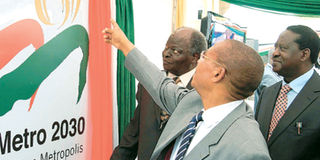Plan to transform city unveiled

President Kibaki (left) and Prime Minister Raila Odinga (right) are shown the new Nairobi Metro 2030 logo by Nairobi Metropolitan minister Mutula Kilonzo at the KICC on Monday. Photo/HEZRON NJOROGE
What you need to know:
- Metropolis will introduce new trains as part of grand vision
A scheduled “smart” bus transport service to ply the city routes; a light rail transport system connecting all the major suburbs within Nairobi and a business park at the Jomo Kenyatta International Airport.
All these are part of a grand plan to transform the city of Nairobi into a major regional business and tourism hub.
The plan, known as the new Nairobi Metro 2030 Strategy, was launched in Nairobi on Monday in Nairobi.
Universities
It seeks to build new local universities and satellite campuses of world-class universities in America and Europe as part of a plan to build a Sh2.2 trillion higher education market that will attract students from all over the world.
The plan envisages a vast metropolis extending all the way to Limuru, Machakos, Ruiru, Kangundo, Thika and as far as Namanga on the Kenya-Tanzania Border.
The minister for Nairobi Metropolitan Development, Mr Mutula Kilonzo, says the entire plan will cost Sh33.2 trillion.
However, he did not make it clear how this money is to be raised considering that Kenya’s Budget for the current financial year is about Sh700 billion.
At that rate, it could take the country 47 years to realise this dream, using all the money meant for the national Budget. But then, Mr Mutula is seeking to achieve the dream city status by 2030 — 20 years from now.
The vision for the city has exceeded the earlier goal of restoring Nairobi’s reputation as “the green city in the sun”. The new goal is to make Nairobi “a world-class African metropolis.”
Key goals
Among the key goals of the strategy is for Kenya to host the All Africa Games in 2015 and the Commonwealth games in 2018.
The ambitious plan aims to create 100,000 new jobs by 2012 by tapping into the fast-growing Information Communication Technology sector.
In terms of business investments, Sh133 billion is required to automate the traffic management system and develop infrastructure.
The Nairobi River will also be cleaned up as part of a broader campaign to reduce pollution and protect the environment.
The Nairobi Metropolitan region covers 15 local authorities among them Thika, Machakos, Tala-Kangundo, Limuru, Kiambu and Ol Kejuado. Others are Masaku, Ruiru, Kikuyu, Karuri, Mavoko and Nairobi itself.
Addressing the public during the launch, President Kibaki asked local authorities to manage their revenue more prudently.
“It will be necessary to place these local authorities under a common Nairobi Metropolitan governance framework,” he said.
However, he said the councils under the metropolis would remain independent and continue with service provision.




